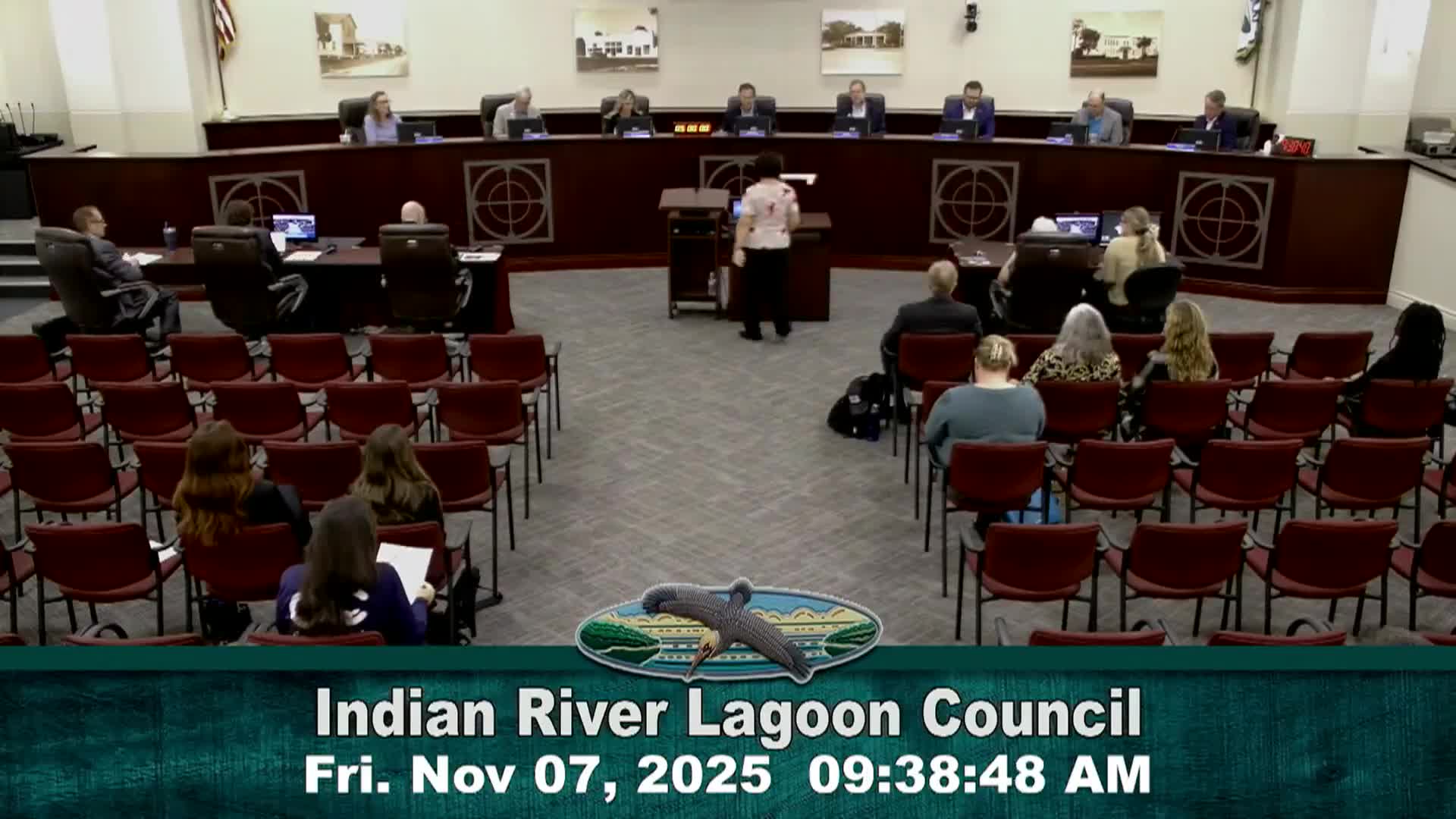Monitoring shows high water, lower salinity in places; seagrass improving in parts of lagoon
November 08, 2025 | Sebastian , Indian River County, Florida
This article was created by AI summarizing key points discussed. AI makes mistakes, so for full details and context, please refer to the video of the full meeting. Please report any errors so we can fix them. Report an error »

Lauren Hall, an environmental scientist with the St. Johns River Water Management District, told the Indian River Lagoon Council on Nov. 7 that August–October rainfall was above average and that some localized Titusville sites recorded more than 20 inches in October.
Hall said continuous-monitoring sites recorded very high water levels — ‘‘at least half a meter higher than what I’m expecting when I arrive at these sites’’ — and salinity declines in response to the heavy rain, with Banana River and Titusville stations now under 20 practical salinity units (PSU) at times. She noted the Vero Beach sensor shows greater variability because it sits near freshwater tributaries and higher in the water column.
The sea‑temperature trend was typical for autumn, Hall said, which should make oxygen conditions more favorable as water cools. Dissolved oxygen data showed only brief portions of hypoxic conditions below 2 milligrams per liter; Hall said hypoxia has been limited recently. Turbidity was more variable because the fall combined heavy rains with windy conditions.
On seagrass, Hall reported mixed results from 2024 to summer 2025: northern subbasins, including the Northern Indian River Lagoon and parts of Mosquito Lagoon, showed increases in transect length and mean transect cover, while Central Indian River Lagoon showed little or no gain. Hall said summer transect surveys indicate gains in some areas but full 2025 mapping results were still pending.
Melanie Parker of the South Florida Water Management District briefed the council on the St. Lucie Estuary. Parker said daily inflows through Oct. 26 included no Lake Okeechobee discharges in that period and that salinity trends fell through late summer but had climbed back with drier conditions. She compared short‑term sensor data to oyster performance ranges (optimal 10–25 PSU; stressful 5–9 PSU or >25 PSU; damaging below 5 PSU) and said some surface readings in the North Fork briefly entered the ‘‘damaging’’ range during heavy rain but recovered quickly.
Parker presented oyster monitoring results showing recruitment delayed in 2025 compared with previous years but a June peak of 17.7 spat per shell and a September density of about 965 oysters per square meter — an outcome her team called encouraging for the season.
Council members asked about longer‑term trends and local drivers such as upstream reservoir operations and reduced discharges; members and staff referenced recent investments in storage and conveyance intended to reduce harmful freshwater pulses. The presenters noted that seagrass mapping and continuing sensor records will provide additional context for winter and spring conditions.
The council received the reports; no formal action was taken.
Hall said continuous-monitoring sites recorded very high water levels — ‘‘at least half a meter higher than what I’m expecting when I arrive at these sites’’ — and salinity declines in response to the heavy rain, with Banana River and Titusville stations now under 20 practical salinity units (PSU) at times. She noted the Vero Beach sensor shows greater variability because it sits near freshwater tributaries and higher in the water column.
The sea‑temperature trend was typical for autumn, Hall said, which should make oxygen conditions more favorable as water cools. Dissolved oxygen data showed only brief portions of hypoxic conditions below 2 milligrams per liter; Hall said hypoxia has been limited recently. Turbidity was more variable because the fall combined heavy rains with windy conditions.
On seagrass, Hall reported mixed results from 2024 to summer 2025: northern subbasins, including the Northern Indian River Lagoon and parts of Mosquito Lagoon, showed increases in transect length and mean transect cover, while Central Indian River Lagoon showed little or no gain. Hall said summer transect surveys indicate gains in some areas but full 2025 mapping results were still pending.
Melanie Parker of the South Florida Water Management District briefed the council on the St. Lucie Estuary. Parker said daily inflows through Oct. 26 included no Lake Okeechobee discharges in that period and that salinity trends fell through late summer but had climbed back with drier conditions. She compared short‑term sensor data to oyster performance ranges (optimal 10–25 PSU; stressful 5–9 PSU or >25 PSU; damaging below 5 PSU) and said some surface readings in the North Fork briefly entered the ‘‘damaging’’ range during heavy rain but recovered quickly.
Parker presented oyster monitoring results showing recruitment delayed in 2025 compared with previous years but a June peak of 17.7 spat per shell and a September density of about 965 oysters per square meter — an outcome her team called encouraging for the season.
Council members asked about longer‑term trends and local drivers such as upstream reservoir operations and reduced discharges; members and staff referenced recent investments in storage and conveyance intended to reduce harmful freshwater pulses. The presenters noted that seagrass mapping and continuing sensor records will provide additional context for winter and spring conditions.
The council received the reports; no formal action was taken.
View the Full Meeting & All Its Details
This article offers just a summary. Unlock complete video, transcripts, and insights as a Founder Member.
✓
Watch full, unedited meeting videos
✓
Search every word spoken in unlimited transcripts
✓
AI summaries & real-time alerts (all government levels)
✓
Permanent access to expanding government content
30-day money-back guarantee
